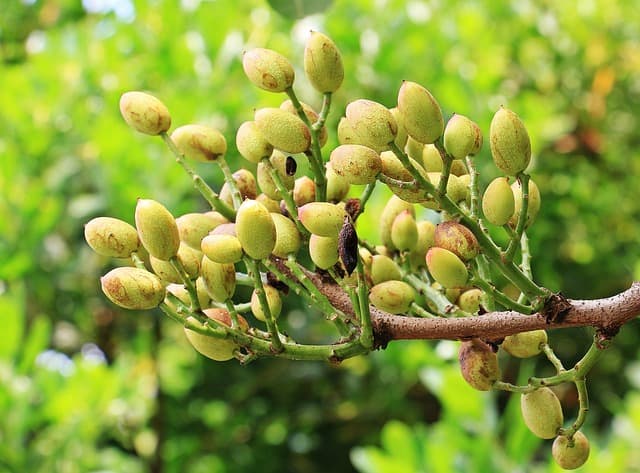Pistachio trees (Pistacia vera) are small to medium-sized deciduous trees that belong to the Anacardiaceae family. They are primarily cultivated for their delicious and nutritious nuts, which are widely consumed around the world. The wood produced by pistachio trees is highly regarded for its unique beauty, featuring warm reddish-brown tones with darker streaks and interesting figuring.
It is a durable hardwood that is sought after by woodworkers for various projects, including furniture, cabinetry, flooring, and decorative items. The wood’s moderate stability and workability make it a popular choice among craftsmen, and its pleasant aroma adds to the overall appeal of working with pistachio wood.
10 Interesting Facts About Pistachio Wood
- Origin: Pistachio wood comes from the Pistacia vera tree, which is native to regions in Western Asia and the Middle East.
- Hardness: Pistachio wood is a hardwood with a Janka hardness rating of around 1,910 lbf, making it relatively dense and durable.
- Grain and Texture: The grain of pistachio wood is typically straight or slightly interlocked, with a medium to fine texture.
- Color: Pistachio wood showcases a range of warm, reddish-brown tones, often with darker streaks and a subtle natural luster.
- Figured Wood: It is known for its interesting figure and figuring, such as curly, quilted, and burl patterns, adding visual appeal to projects.
- Workability: Pistachio wood is generally easy to work with, as it responds well to hand and machine tools, and it holds screws and nails securely.
- Stability: While it has moderate dimensional stability, it is recommended to properly dry and stabilize pistachio wood to minimize any potential movement.
- Uses: Pistachio wood is popular for various woodworking projects, including furniture, cabinetry, flooring, turning, veneer, and small decorative items.
- Sustainability: Pistachio trees are cultivated for their nuts, and the wood is often sourced as a byproduct, making it a sustainable choice for woodworking.
- Unique Aroma: When working with pistachio wood, it can release a pleasant and distinctive aroma, adding to the overall sensory experience.
Pistachio Wood Has Many Useful Applications
Pistachio wood is known for its beautiful appearance and unique properties, making it suitable for various applications. Some common and popular uses for pistachio wood include:
- Fine Furniture: Pistachio wood’s attractive grain patterns and warm color make it a favored choice for crafting high-quality furniture pieces such as tables, chairs, cabinets, and bed frames.
- Flooring: The durability and hardness of pistachio wood make it suitable for flooring applications. It can add a touch of elegance and uniqueness to residential or commercial spaces.
- Turning and Carving: Pistachio wood is prized by woodturners and carvers for its workability. It can be shaped into intricate designs and turned into bowls, vases, and other decorative items.
- Musical Instruments: The resonant properties of pistachio wood make it a desirable material for musical instruments such as guitars, ukuleles, and other stringed instruments.
- Crafts and Decorative Items: Pistachio wood’s unique color and grain make it ideal for crafting small items like jewelry boxes, picture frames, cutting boards, and other decorative pieces.
- Architectural Millwork: Due to its visual appeal and strength, pistachio wood is used for architectural millwork applications such as doors, window frames, moldings, and paneling.
- Knife Handles: Pistachio wood’s hardness and stability make it a suitable material for crafting knife handles that are both functional and visually appealing.
- Inlay Work: The contrasting colors and figuring of pistachio wood make it suitable for inlay work, where thin pieces of wood are incorporated into furniture or other surfaces to create intricate patterns.
- Sculptures and Artwork: Artists and sculptors appreciate the unique character of pistachio wood and use it to create sculptures and artistic installations.
- Craftsman Items: Pistachio wood is often used by artisans and craftsmen to create unique and one-of-a-kind items like pens, keychains, bottle stoppers, and other small handcrafted objects.
These are just a few examples of the many applications for pistachio wood, showcasing its versatility and aesthetic appeal in various fields.
Pistachio Wood Summarized
Here is a table summarizing important facts and figures about pistachio wood:
| Fact | Information |
|---|---|
| Tree Species | Pistacia vera |
| Origin | Western Asia and the Middle East |
| Janka Hardness | 1,910 lbf (pounds-force) |
| Grain | Straight or slightly interlocked |
| Texture | Medium to fine |
| Color | Warm reddish-brown with darker streaks |
| Figure and Figuring | Curly, quilted, burl, and other patterns |
| Workability | Easy to work with, holds screws and nails securely |
| Stability | Moderate, recommend proper drying and stabilization |
| Common Uses | Furniture, cabinetry, flooring, turning, veneer, small items |
| Sustainability and Source | Sourced as a byproduct of pistachio nut cultivation |
| Aroma | Pleasant and distinctive when working with the wood |
Remember to further research and verify specific details as needed, as wood characteristics can vary depending on factors such as growth conditions and individual specimens, depending on the use you have planned.

